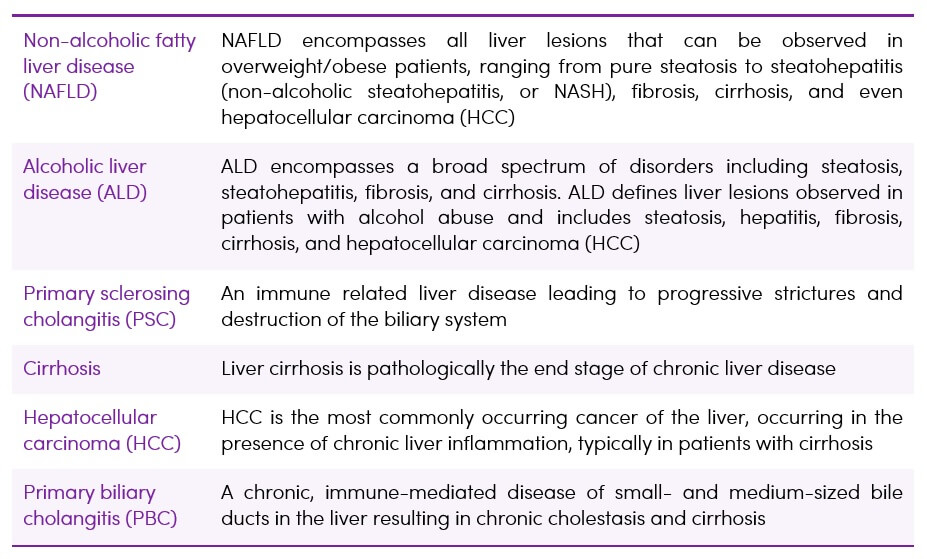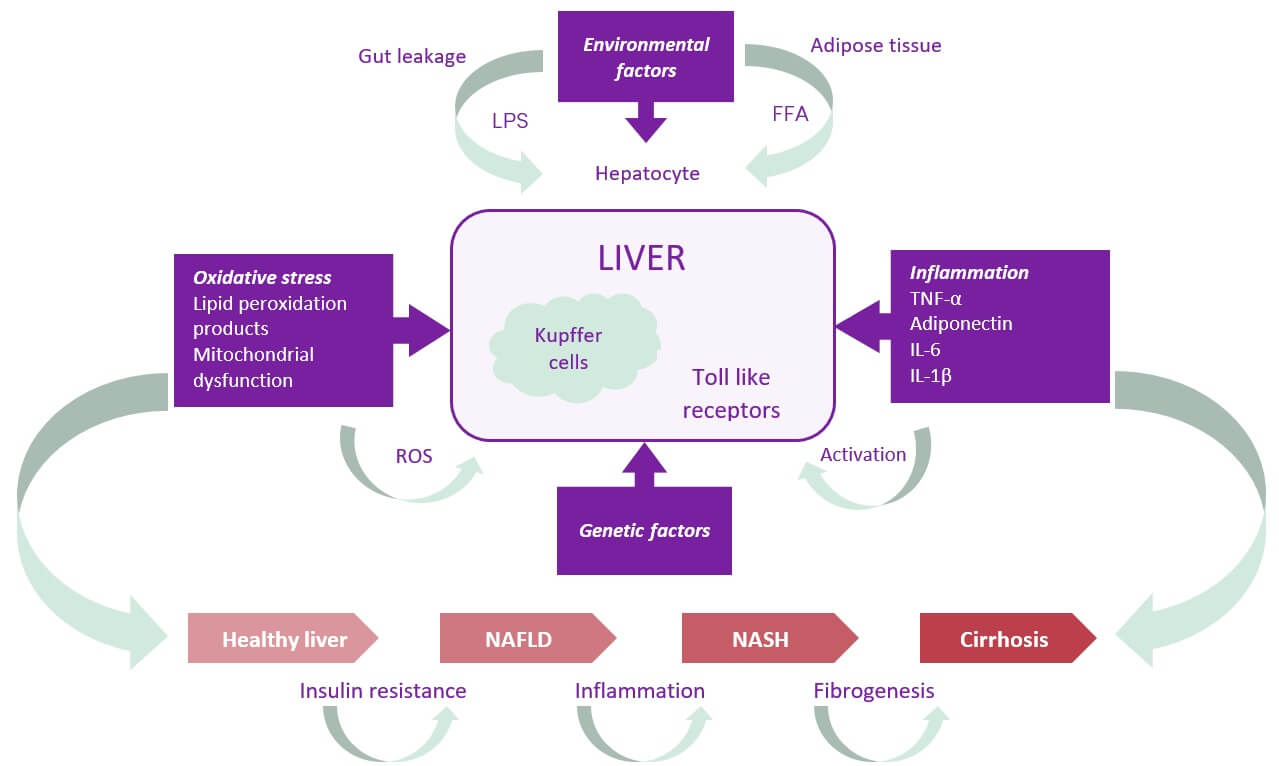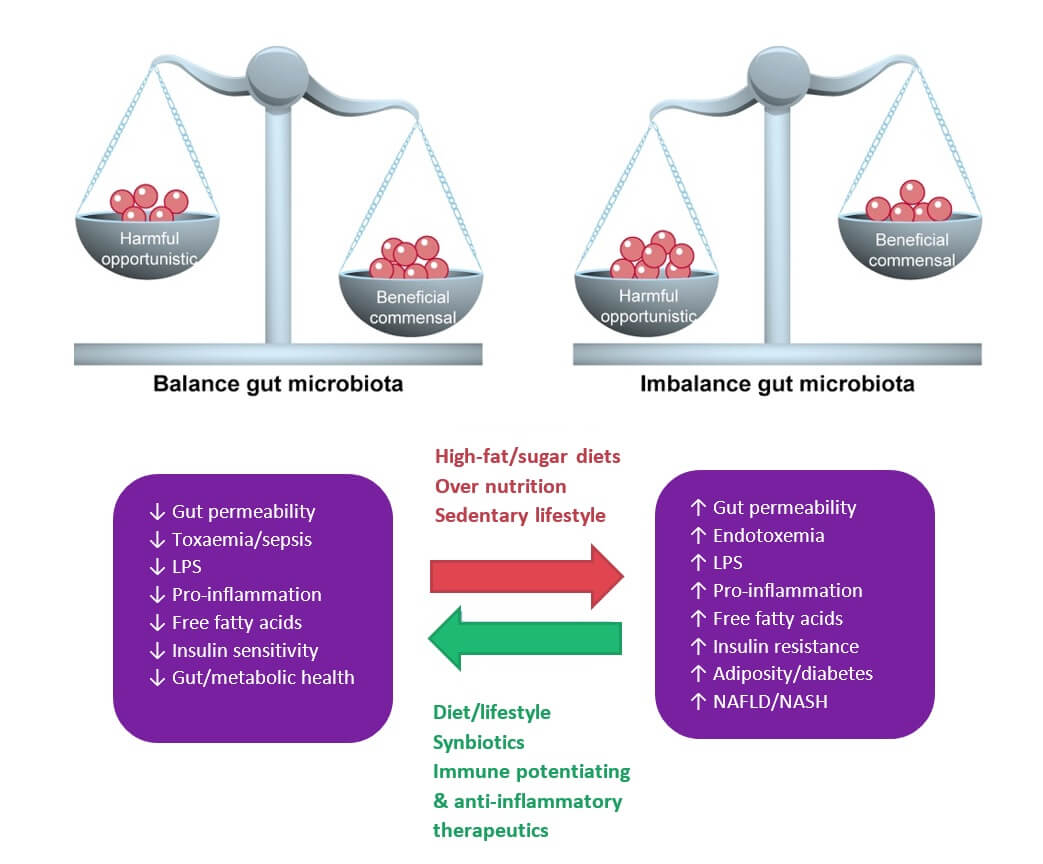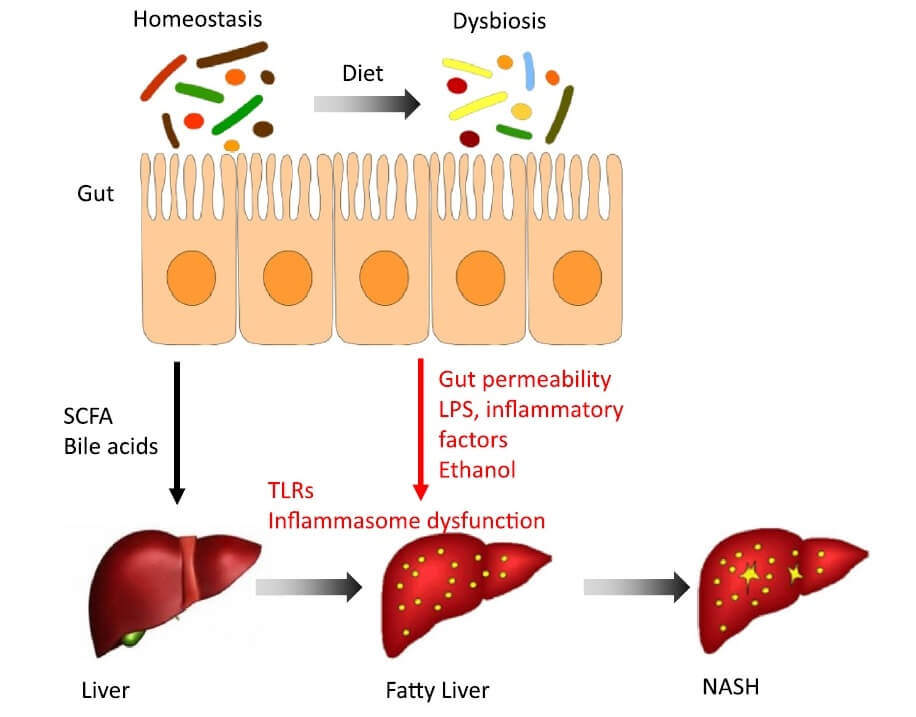The gut microbiota consists of a diverse community of bacterial species in the gastrointestinal (GI) tract which exists symbiotically with the human host. A healthy and stable gut microbiota community plays a vital role in maintaining motility, permeability, secretion and immunity of the gut. The liver is intimately linked to the gut via the portal vein. A healthy or diseased liver may be impacted by exposure to gut microbiota and their metabolites translocating across the gut lumen (1).
There is a wealth of data linking conditions such as non-alcoholic fatty liver disease (NAFLD), alcohol-related liver disease (ALD), primary sclerosing cholangitis (PSC) and cirrhosis with reduced bacterial diversity and gut dysbiosis (1,2).
Table 1. Liver disease definitions

The relationship between the gut microbiota and liver diseases is complex. Gut dysbiosis and the translocation of microbes and/or microbial metabolites across the intestinal epithelium into the mesenteric lymph nodes and liver may influence the degree of hepatic steatosis, inflammation and fibrosis through multiple interactions with the host’s immune system and other cell types including nonparenchymal and parenchymal liver cells. Increased hepatic steatosis, fibrosis and portal hypertension, in turn, exacerbate intestinal permeability resulting in further bacterial translocation (2,3,4).
The liver receives 70% of its blood supply through the portal vein and provides the first-pass metabolism for the GI luminal contents, which include dietary nutrients, toxins and xenobiotics ![]() as well as the gut microbiota and microbial metabolites that translocate across the intestinal epithelium (2). In turn, the liver secretes bile acids which modify the intestinal microbiome and act as signalling molecules between the liver, the gut microbiota and the intestine (5).
as well as the gut microbiota and microbial metabolites that translocate across the intestinal epithelium (2). In turn, the liver secretes bile acids which modify the intestinal microbiome and act as signalling molecules between the liver, the gut microbiota and the intestine (5).
Recent studies have highlighted the causal role of the gut microbiota in the development of liver diseases and the use of probiotics or prebiotics to modulate the gut microbiota improves some parameters associated with liver disease, suggesting a potential preventive or therapeutic strategy for these diseases (1,6).
Figure 1. Pathogenesis of NASH - The “Multiple Hit Theory”. Adapted from (7) CC BY-NC-ND 4.0
The gut microbiota, oxidative stress, and mitochondrial damage play key roles in the pathogenesis of NASH. Inflammation precedes steatosis in environmentally and genetically predisposed subjects. Numerous insults act together to induce NAFLD, including insulin resistance, hormones secreted from the adipose tissue, nutritional factors, endotoxins (lipopolysaccharide) released by the gut microbiota, oxidative stress damage, and genetic and epigenetic factors. These insults act on liver parenchymal cells via toll-like receptors to drive the progression of NASH.

Traditional Understanding
It has long been recognised that microbial translocation releases bacterial products that play a key role in the progression of chronic liver disease by promoting hepatic injury and inflammation. It is only fairly recently however, that we are beginning to understand the circumstances under which gut permeability occurs and to discover bacterial metabolites that promote liver disease (8).
Latest Research
Non-alcoholic fatty liver disease (NAFLD)/Non-alcoholic steatohepatitis (NASH)
Studies show that the intestinal microbiota and dysbiosis play an important role in the pathogenesis and severity of NAFLD/NASH.
Figure 2. Importance of balanced gut microbiota and the consequences of gut dysbiosis. Adapted from (7) CC BY-NC-ND 4.0

- Altered microbiome composition and diversity are demonstrated in individuals with NAFLD/NASH, however, no consistent causative microbiota signature has been identified. Evidence indicates that individuals with NASH have a high prevalence (50% – 78%) of small intestinal bacterial overgrowth (SIBO) (2,6,9,10)
- Increase in intestinal permeability is five times more likely to occur in individuals with NAFLD compared with healthy individuals (11)
- NAFLD and NASH are commonly associated with obesity and other components of the metabolic syndrome which are linked to the changes in the intestinal microbiome. Changes in the composition of the intestinal microbiome associated with carbohydrate, lipid and protein metabolism predict NAFLD severity (12)
- Bifidobacteria appear to have a protective role against the development of NAFLD and obesity, highlighting their possible use in treatment and prevention (13)
- Immunomodulatory bacterial metabolites play an important role in NAFLD (14)
Figure 3. Effect of gut microbiome in NAFLD development and progression to NASH. Adapted from (15) CC BY-NC-ND 4.0

Alcoholic liver disease (ALD)
The spectrum of ALD ranges from simple alcoholic steatosis to steatohepatitis, eventually progressing to fibrosis and cirrhosis. The gut microbiota changes both quantitatively and qualitatively in the setting of ALD, with the development of SIBO and dysbiosis (2).
- Individual susceptibility to ALD is substantially driven by the gut microbiome and there is strong evidence for a causal role of the microbiome in ALD (6,16)
- Disruption of the gut barrier is a prerequisite for ALD, resulting in bacterial translocation. Alcohol consumption disrupts the gut barrier, increases gut permeability and induces bacterial translocation both in ALD patients and in experimental models with ALD. Alcohol consumption also causes dysbiosis with changes in both the quantity and ratios of microbiome populations (17)
- Research suggests that the control of bacterial overgrowth and adherent bacterial content is essential to the protective mechanisms against alcohol-induced liver toxicity (6,18)
- Metabolites produced by the gut microbiome are involved not only in cell dysfunction and liver disease but also in the psychological symptoms of alcohol dependence (19)
Advanced liver disease
Fibrosis, cirrhosis, hepatocellular carcinoma (HCC), primary biliary cholangitis (PBC) and primary sclerosing cholangitis (PSC) are all associated with gut microbiome changes, including dysbiosis and gut permeability (20).
The gut microbiota is critically important in the development of hepatic fibrogenesis. The composition and function of the gut microbiota are altered in patients with fibrosis (21). Increased circulating lipopolysaccharide (LPS) levels lead to a chronic inflammatory state leading to the development of hepatic fibrosis and eventually cirrhosis (2).
- Profound changes in the microbiota occur with the development of liver cirrhosis and individuals with cirrhosis have distinct faecal microbial communities relative to healthy individuals, with an overall decrease in microbiome diversity (2,6). Dysbiosis, SIBO and increased gut permeability allow bacterial translocation and uptake of endotoxins, inducing hepatic and systemic inflammation (1)
- Many bacteria enriched in the gut microbiota of cirrhotic patients appear to be of oral origin, suggesting an invasion of the lower intestinal tract by the oral microbiome (22)
- Bacterial translocation seems to play an important role as the trigger in cirrhosis, while complications of liver cirrhosis are mainly due to portal hypertension (PHT). Systemic pro-inflammatory states might persist after efficient treatment of PHT, fuelling immune dysregulation and further triggering the development of acute-on-chronic liver failure (ACLF). Microbiome and inflammation directed treatments are emerging as promising targets in ACLF (4)
- Results from a Cochrane review indicate that lactulose reduces complications of cirrhosis such as liver failure, hepatorenal syndrome, variceal bleeding and overall mortality (23)
- Evidence suggests that the gut microbiome could be involved in the initiation and progression of HCC via alterations in bile acid metabolism and release of inflammatory cytokines (6,9)





